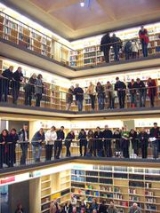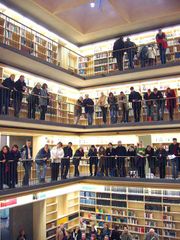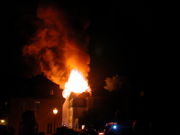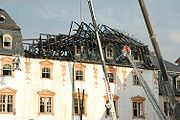
Duchess Anna Amalia Library
Encyclopedia
The Duchess Anna Amalia Library (German: Herzogin Anna Amalia Bibliothek) in Weimar
, Thuringia
, Germany
, houses a major collection of German literature and historical documents. The library contains:

The research library today has approximately 850,000 volumes with collection emphasis on the German literature
. Among its special collections is an important Shakespeare collection of approximately 10,000 volumes, as well as a 16th century Bible
connected to Martin Luther
.
The main building is the Green Castle (Grünes Schloss), Anna's residence, which had been built between 1562 and 1565. The dowager Duchess had the building converted into a library
in 1761. The Duchess, seeking a tutor for her son Duke Carl August
, hired Christoph Martin Wieland
, an important poet and noted translator of William Shakespeare
. Wieland's Shakespeare volumes formed the core of the collection. From an architectural standpoint, the library is world famous for its oval Rococo
hall featuring a portrait of Grand Duke Carl August.
 One of the library's most famous patrons was Johann Wolfgang von Goethe
One of the library's most famous patrons was Johann Wolfgang von Goethe
, who worked there from 1797 to 1832. The library also includes the world's largest Faust
collection. The Duchess's significant 13,000-volume music collection is also available in the library.
In World War II
, most of the collection was housed elsewhere to preserve it from Allied bombing.
Today, the library is a public research library for literature and art history. The main focus is German literature
from the Classical and the late Romantic eras.
The new development is estimated to cost €24 million and has an area of 6,300 m². The area is divided into upper and lower floors. The new building would connect the historical library building with the user areas of the reconstructed Red and Yellow Castle. The grand opening of the new complex is slated for February 2005.

 Part of the collection was burned in a fire on 2 September 2004, which destroyed 50,000 volumes of which 12,500 are considered irreplaceable. Another 62,000 volumes were severely damaged. However, some 6,000 historical works were saved, including the 1534 Luther Bible
Part of the collection was burned in a fire on 2 September 2004, which destroyed 50,000 volumes of which 12,500 are considered irreplaceable. Another 62,000 volumes were severely damaged. However, some 6,000 historical works were saved, including the 1534 Luther Bible
and a collection of Alexander von Humboldt
's papers, by being passed hand-over-hand out of the building. 28,000 books in the building were not affected by the fire. Other items, like Friedrich Schiller
's death mask suffered damage, too, and 35 historic oil paintings were destroyed.
The fire came as a particular tragedy, in part because the collection was scheduled to move to another site in late October, little more than a month later. Some of the damaged books are being freeze-dried in Leipzig
to save them from rotting as a result of water damage. Book restoration is scheduled to last at least until 2015.
In June 2005, it was announced that manuscripts that were out of the building at the time of the fire, and thus saved, included a hitherto undiscovered 1713 aria
by Johann Sebastian Bach
titled "Alles mit Gott und nichts ohn' ihn".
The library building was restored for $18.2 million and reopened at the end of October 2007 with some 60,000 volumes. This includes the unaffected books, the first restored books and replacements which have been obtained on the international antique book market, from other libraries, or were donated. An online database lists the books the library still wants to obtain to replace lost volumes.
Weimar
Weimar is a city in Germany famous for its cultural heritage. It is located in the federal state of Thuringia , north of the Thüringer Wald, east of Erfurt, and southwest of Halle and Leipzig. Its current population is approximately 65,000. The oldest record of the city dates from the year 899...
, Thuringia
Thuringia
The Free State of Thuringia is a state of Germany, located in the central part of the country.It has an area of and 2.29 million inhabitants, making it the sixth smallest by area and the fifth smallest by population of Germany's sixteen states....
, Germany
Germany
Germany , officially the Federal Republic of Germany , is a federal parliamentary republic in Europe. The country consists of 16 states while the capital and largest city is Berlin. Germany covers an area of 357,021 km2 and has a largely temperate seasonal climate...
, houses a major collection of German literature and historical documents. The library contains:

- 1,000,000 books
- 2,000 medieval and early modern manuscripts
- 600 ancestral registers
- 10,000 maps
- 4,000 musical scripts
The research library today has approximately 850,000 volumes with collection emphasis on the German literature
German literature
German literature comprises those literary texts written in the German language. This includes literature written in Germany, Austria, the German part of Switzerland, and to a lesser extent works of the German diaspora. German literature of the modern period is mostly in Standard German, but there...
. Among its special collections is an important Shakespeare collection of approximately 10,000 volumes, as well as a 16th century Bible
Bible
The Bible refers to any one of the collections of the primary religious texts of Judaism and Christianity. There is no common version of the Bible, as the individual books , their contents and their order vary among denominations...
connected to Martin Luther
Martin Luther
Martin Luther was a German priest, professor of theology and iconic figure of the Protestant Reformation. He strongly disputed the claim that freedom from God's punishment for sin could be purchased with money. He confronted indulgence salesman Johann Tetzel with his Ninety-Five Theses in 1517...
.
History
The Duchess Anna Amalia Library is named for Anna Amalia, Duchess of Saxe-Weimar-Eisenach, who arranged in 1766 for the courtly (hoefische) book collection to be moved into the library.The main building is the Green Castle (Grünes Schloss), Anna's residence, which had been built between 1562 and 1565. The dowager Duchess had the building converted into a library
Library
In a traditional sense, a library is a large collection of books, and can refer to the place in which the collection is housed. Today, the term can refer to any collection, including digital sources, resources, and services...
in 1761. The Duchess, seeking a tutor for her son Duke Carl August
Carl August, Grand Duke of Saxe-Weimar-Eisenach
Karl August, Grand Duke of Saxe-Weimar-Eisenach was a duke of Saxe-Weimar and of Saxe-Eisenach from 1758, duke of Saxe-Weimar-Eisenach from its creation in 1809, and grand duke from 1815 until his death...
, hired Christoph Martin Wieland
Christoph Martin Wieland
Christoph Martin Wieland was a German poet and writer.- Biography :He was born at Oberholzheim , which then belonged to the Free Imperial City of Biberach an der Riss in the south-east of the modern-day state of Baden-Württemberg...
, an important poet and noted translator of William Shakespeare
William Shakespeare
William Shakespeare was an English poet and playwright, widely regarded as the greatest writer in the English language and the world's pre-eminent dramatist. He is often called England's national poet and the "Bard of Avon"...
. Wieland's Shakespeare volumes formed the core of the collection. From an architectural standpoint, the library is world famous for its oval Rococo
Rococo
Rococo , also referred to as "Late Baroque", is an 18th-century style which developed as Baroque artists gave up their symmetry and became increasingly ornate, florid, and playful...
hall featuring a portrait of Grand Duke Carl August.

Johann Wolfgang von Goethe
Johann Wolfgang von Goethe was a German writer, pictorial artist, biologist, theoretical physicist, and polymath. He is considered the supreme genius of modern German literature. His works span the fields of poetry, drama, prose, philosophy, and science. His Faust has been called the greatest long...
, who worked there from 1797 to 1832. The library also includes the world's largest Faust
Faust
Faust is the protagonist of a classic German legend; a highly successful scholar, but also dissatisfied with his life, and so makes a deal with the devil, exchanging his soul for unlimited knowledge and worldly pleasures. Faust's tale is the basis for many literary, artistic, cinematic, and musical...
collection. The Duchess's significant 13,000-volume music collection is also available in the library.
In World War II
World War II
World War II, or the Second World War , was a global conflict lasting from 1939 to 1945, involving most of the world's nations—including all of the great powers—eventually forming two opposing military alliances: the Allies and the Axis...
, most of the collection was housed elsewhere to preserve it from Allied bombing.
Today, the library is a public research library for literature and art history. The main focus is German literature
German literature
German literature comprises those literary texts written in the German language. This includes literature written in Germany, Austria, the German part of Switzerland, and to a lesser extent works of the German diaspora. German literature of the modern period is mostly in Standard German, but there...
from the Classical and the late Romantic eras.
Modern extension
In 2001, construction began on a new multiple-floor facility to house some 1,000,000 books under the "Plaza of Democracy" (Platz der Demokratie) between the Music University and the Red and Yellow Castle. In its pre-renovation state, the building had structural flaws which endangered many valuable books and the special collections.The new development is estimated to cost €24 million and has an area of 6,300 m². The area is divided into upper and lower floors. The new building would connect the historical library building with the user areas of the reconstructed Red and Yellow Castle. The grand opening of the new complex is slated for February 2005.
Fire of 2004


Bible
The Bible refers to any one of the collections of the primary religious texts of Judaism and Christianity. There is no common version of the Bible, as the individual books , their contents and their order vary among denominations...
and a collection of Alexander von Humboldt
Alexander von Humboldt
Friedrich Wilhelm Heinrich Alexander Freiherr von Humboldt was a German naturalist and explorer, and the younger brother of the Prussian minister, philosopher and linguist Wilhelm von Humboldt...
's papers, by being passed hand-over-hand out of the building. 28,000 books in the building were not affected by the fire. Other items, like Friedrich Schiller
Friedrich Schiller
Johann Christoph Friedrich von Schiller was a German poet, philosopher, historian, and playwright. During the last seventeen years of his life , Schiller struck up a productive, if complicated, friendship with already famous and influential Johann Wolfgang von Goethe...
's death mask suffered damage, too, and 35 historic oil paintings were destroyed.
The fire came as a particular tragedy, in part because the collection was scheduled to move to another site in late October, little more than a month later. Some of the damaged books are being freeze-dried in Leipzig
Leipzig
Leipzig Leipzig has always been a trade city, situated during the time of the Holy Roman Empire at the intersection of the Via Regia and Via Imperii, two important trade routes. At one time, Leipzig was one of the major European centres of learning and culture in fields such as music and publishing...
to save them from rotting as a result of water damage. Book restoration is scheduled to last at least until 2015.
In June 2005, it was announced that manuscripts that were out of the building at the time of the fire, and thus saved, included a hitherto undiscovered 1713 aria
Aria
An aria in music was originally any expressive melody, usually, but not always, performed by a singer. The term is now used almost exclusively to describe a self-contained piece for one voice usually with orchestral accompaniment...
by Johann Sebastian Bach
Johann Sebastian Bach
Johann Sebastian Bach was a German composer, organist, harpsichordist, violist, and violinist whose sacred and secular works for choir, orchestra, and solo instruments drew together the strands of the Baroque period and brought it to its ultimate maturity...
titled "Alles mit Gott und nichts ohn' ihn".
The library building was restored for $18.2 million and reopened at the end of October 2007 with some 60,000 volumes. This includes the unaffected books, the first restored books and replacements which have been obtained on the international antique book market, from other libraries, or were donated. An online database lists the books the library still wants to obtain to replace lost volumes.
External links
- Duchess Anna Amalia Library - official site
- Library Goes up in Flames, Destroying Literary Legacy
- (Jerusalem Post)
- Associated Press article
- BBC article
- MSNBC article
- New York Times article
- Muslim Librarians Visit Germany: The Catalogues of the Queen of Sheba
- 360° Flash-Panoramas: 2004 before fire, 2004 back fire

